

Structural basis for inhibition of the RNA-dependent RNA polymerase from SARS-CoV-2 by remdesivir. A wrench in the works of COVID-19 Understanding the inner workings of the virus that causes coronavirus disease 2019 (COVID-19) may help us to disrupt it.
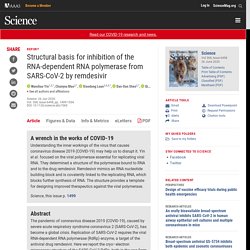
Yin et al. focused on the viral polymerase essential for replicating viral RNA. They determined a structure of the polymerase bound to RNA and to the drug remdesivir. Remdesivir mimics an RNA nucleotide building block and is covalently linked to the replicating RNA, which blocks further synthesis of RNA. The structure provides a template for designing improved therapeutics against the viral polymerase. Science, this issue p. 1499 Abstract. Studies in humanized mice and convalescent humans yield a SARS-CoV-2 antibody cocktail. Abstract Neutralizing antibodies have become an important tool in treating infectious diseases.
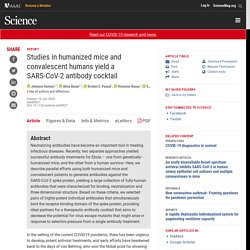
Recently, two separate approaches yielded successful antibody treatments for Ebola – one from genetically-humanized mice, and the other from a human survivor. Here, we describe parallel efforts using both humanized mice and convalescent patients to generate antibodies against the SARS-CoV-2 spike protein, yielding a large collection of fully-human antibodies that were characterized for binding, neutralization and three dimensional structure. Based on these criteria, we selected pairs of highly-potent individual antibodies that simultaneously bind the receptor-binding domain of the spike protein, providing ideal partners for a therapeutic antibody cocktail that aims to decrease the potential for virus escape mutants that might arise in response to selective pressure from a single antibody treatment. Robust T cell immunity in convalescent individuals with asymptomatic or mild COVID-19.
Nejm. Coronavirus (SRAS-CoV et MERS-CoV) ACTIV. Overview On April 17, 2020 the National Institutes of Health (NIH) announced the Accelerating COVID-19 Therapeutic Interventions and Vaccines (ACTIV) public-private partnership to develop a coordinated research strategy for prioritizing and speeding development of the most promising treatments and vaccines.

Coordinated by the Foundation for the National Institutes of Health (FNIH), ACTIV brings NIH together with its sibling agencies in the Department of Health and Human Services, including the Biomedical Advanced Research and Development Authority (BARDA), Centers for Disease Control and Prevention (CDC), and the U.S. Food and Drug Administration (FDA); other government agencies including the Department of Defense (DOD) and Department of Veterans Affairs (VA); the European Medicines Agency (EMA); and representatives from academia, philanthropic organizations, and numerous biopharmaceutical companies. Challenge Opportunity Fast Track Area #1 How we plan to accomplish this: Fast Track Area #2.
Study in Primates Finds Acquired Immunity Prevents COVID-19 Reinfections. Posted on July 14th, 2020 by Dr.
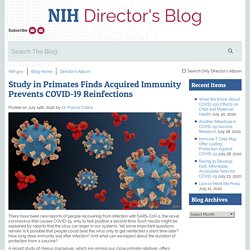
Francis Collins. Primary exposure to SARS-CoV-2 protects against reinfection in rhesus macaques - PubMed. Six Months of Coronavirus: Here’s Some of What We’ve Learned. The time course of the immune response to experimental coronavirus infection of man - PubMed. Immunity to COVID-19 is probably higher than tests have shown. Immune T Cells May Offer Lasting Protection Against COVID-19. Posted on July 28th, 2020 by Dr.
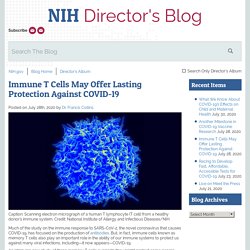
Francis Collins Much of the study on the immune response to SARS-CoV-2, the novel coronavirus that causes COVID-19, has focused on the production of antibodies. But, in fact, immune cells known as memory T cells also play an important role in the ability of our immune systems to protect us against many viral infections, including—it now appears—COVID-19. An intriguing new study of these memory T cells suggests they might protect some people newly infected with SARS-CoV-2 by remembering past encounters with other human coronaviruses.
This might potentially explain why some people seem to fend off the virus and may be less susceptible to becoming severely ill with COVID-19. The findings, reported in the journal Nature, come from the lab of Antonio Bertoletti at the Duke-NUS Medical School in Singapore [1]. SARS-CoV-2-specific T cell immunity in cases of COVID-19 and SARS, and uninfected controls. Data reporting No statistical methods were used to predetermine sample size.
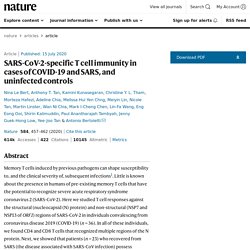
The experiments were not randomized and the investigators were not blinded to allocation during experiments and outcome assessment. Ethics statement All donors provided written consent. The study was conducted in accordance with the Declaration of Helsinki and approved by the NUS Institutional Review Board (H-20-006) and the SingHealth Centralised Institutional Review Board (reference CIRB/F/2018/2387).
Assay Services, Simoa, Erenna, MSD, Cell-Based Assays, CPE, Cytopathic Effect, Neutralization, GIA, Bioassay, Bioactivity, Antibody Characterization, Cytotoxicity, Immunoassay Development, Dose Response. Capturing Viral Shedding in Action. Posted on April 28th, 2020 by Dr.
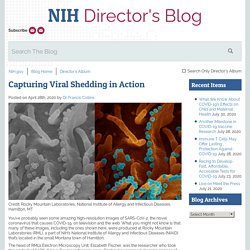
Francis Collins You’ve probably seen some amazing high-resolution images of SARS-CoV-2, the novel coronavirus that causes COVID-19, on television and the web. What you might not know is that many of these images, including the ones shown here, were produced at Rocky Mountain Laboratories (RML), a part of NIH’s National Institute of Allergy and Infectious Diseases (NIAID) that’s located in the small Montana town of Hamilton. The head of RML’s Electron Microscopy Unit, Elizabeth Fischer, was the researcher who took this portrait of SARS-CoV-2.
For more than 25 years, Fischer has snapped stunning images of dangerous viruses and microbes, including some remarkable shots of the deadly Ebola virus. Enlisting Monoclonal Antibodies in the Fight Against COVID-19. Posted on May 21st, 2020 by Dr.
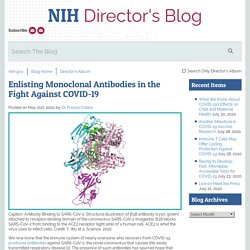
Francis Collins We now know that the immune system of nearly everyone who recovers from COVID-19 produces antibodies against SARS-CoV-2, the novel coronavirus that causes this easily transmitted respiratory disease [1]. Seeing Coronavirus Replicate in Kidney Cells. Posted on July 7th, 2020 by Dr.

Francis Collins You’ve probably seen pictures of SARS-CoV-2—the novel coronavirus that causes COVID-19—that look alarming. But the high-resolution micrograph above paints a rather different picture, using rich pseudo-colors to show how newly assembled viral particles cause infected cells to bulge, or bleb, and then self-destruct. Cytokine release syndrome in severe COVID-19. In December 2019, a new strain of coronavirus, severe acute respiratory syndrome–coronavirus 2 (SARS-CoV-2), was recognized to have emerged in Wuhan, China.
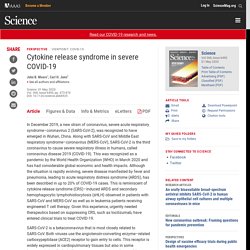
Along with SARS-CoV and Middle East respiratory syndrome–coronavirus (MERS-CoV), SARS-CoV-2 is the third coronavirus to cause severe respiratory illness in humans, called coronavirus disease 2019 (COVID-19). This was recognized as a pandemic by the World Health Organization (WHO) in March 2020 and has had considerable global economic and health impacts.
Although the situation is rapidly evolving, severe disease manifested by fever and pneumonia, leading to acute respiratory distress syndrome (ARDS), has been described in up to 20% of COVID-19 cases. Effectiveness of airport screening at detecting travellers infected with novel coronavirus COVID-19 (formerly 2019-nCoV) Coronavirus Covid-19 (ex 2019-nCov) Publié le31.03.20mise à jour15.05.20. Susceptibility of ferrets, cats, dogs, and other domesticated animals to SARS–coronavirus 2. Alternative hosts and model animals The severe acute respiratory syndrome–coronavirus 2 (SARS-CoV-2) pandemic may have originated in bats, but how it made its way into humans is unknown. Because of its zoonotic origins, SARS-CoV-2 is unlikely to exclusively infect humans, so it would be valuable to have an animal model for drug and vaccine development.
Shi et al. tested ferrets, as well as livestock and companion animals of humans, for their susceptibility to SARS-CoV-2 (see the Perspective by Lakdawala and Menachery). The authors found that SARS-CoV-2 infects the upper respiratory tracts of ferrets but is poorly transmissible between individuals. In cats, the virus replicated in the nose and throat and caused inflammatory pathology deeper in the respiratory tract, and airborne transmission did occur between pairs of cats.
Science, this issue p. 1016; see also p. 942 Abstract Ferrets are commonly used as an animal model for viral respiratory infections in humans (20–26). Projecting the transmission dynamics of SARS-CoV-2 through the postpandemic period. What happens next? Four months into the severe acute respiratory syndrome–coronavirus 2 (SARS-CoV-2) outbreak, we still do not know enough about postrecovery immune protection and environmental and seasonal influences on transmission to predict transmission dynamics accurately.
However, we do know that humans are seasonally afflicted by other, less severe coronaviruses. Kissler et al. used existing data to build a deterministic model of multiyear interactions between existing coronaviruses, with a focus on the United States, and used this to project the potential epidemic dynamics and pressures on critical care capacity over the next 5 years. USG + U.S. Chamber of Commerce Commercial Construction Index - COVID-19 Impacts. 2020 Capacity to Combat Corruption Index - COVID-19 Challenges. COVID-19 is posing unprecedented challenges to Latin America, including its efforts to combat corruption.
All countries in the region have been forced to swiftly mobilize massive resources to fight the virus and to mitigate its economic fallout. In this environment of emergency spending, relaxed controls, and remote working, the risk of corruption and mismanagement of funds has increased. Video: The 2020 CCC Index Launch Against this backdrop, AS/COA and Control Risks are launching the second edition of the Capacity to Combat Corruption (CCC) Index. The index was launched in 2019 to assess Latin American countries’ ability to uncover, punish, and prevent corruption. Rather than measuring perceived levels of corruption, the CCC Index evaluates and ranks countries based on how effectively they are able to combat corruption. The ranking is: For media inquiries or to speak with an expert on this topic, please contact Pia Fuentealba at mediarelations@as-coa.org.
World Economic Forum: The Institution Behind ‘The Great Reset’ – Steven Guinness. In a recent article I briefly examined a number of advances that global planners made prior to the World Economic Forum’s announcement in June of a new initiative dubbed ‘The Great Reset‘. Taken together, the United Nation’s Agenda 2030, the Paris Climate Agreement, the Fourth Industrial Revolution and the Bank for International Settlement’s ‘Innovation BIS 2025‘ offer an insight into how elites want to turn the lives of every man, woman and child inside out over the course of the next decade.
Details of ‘The Great Reset‘ came as nations began to reopen their economies following a global lockdown. The extent to which Covid-19 has dominated every facet of existence – largely because of unrepentant media coverage – has encouraged people to focus exclusively on what life will be like after the virus. For many, what came before now seems inconsequential. It is anything but. Covid-19 and Information Literacy: a selective list of useful resources. Blog posts: A couple of blog articles which set the scene and underline the importance of media/information literacy in the context of the pandemic: Covid-19: seeking reliable information in difficult times: blog post on the CILIP Information Literacy Group site by David Bedford, Academic Support Librarian at the Drill Hall Library, Universities at Medway, highlighting key sources of information on the Covid-19 outbreakCovid-19: searching for the truth in post-truth times: blog post on the JCS website from Julie Greenhough, EPQ Coordinator at St Benedict’s School, on what good (and bad) information practices tell us about Covid-19What the Covid-19 pandemic is teaching us about information literacy: blog post on the Designer Library website, which reflects on the psychology of information behaviour and the importance of data literacy Scientific evidence:
NIH: National Institute of Allergy and Infectious Diseases. The NIAID Integrated Research Facility (IRF) at Fort Detrick, Maryland, is a biosafety level (BSL)-2 to BSL-4 laboratory with unique medical imaging capabilities. The facility was built in accordance with Centers for Disease Control and Prevention (CDC) and National Institutes of Health biosafety standards. NIH: National Institute of Allergy and Infectious Diseases. Coronavirus (COVID-19) Response. Coronavirus (COVID-19) Loading Skip to main content Site Menu. Infection à coronavirus. Plateforme téléphonique -Coronavirus (SARS-CoV-2, Covid-19) : numéros utiles. Government Response to Coronavirus, COVID-19.
COVID-19. SARS-COV-2. Viral Health. Science Mag.Org. Ripping. Roundabout. Pandemic Problems. Medical Preprints, Journal and Science Articles.